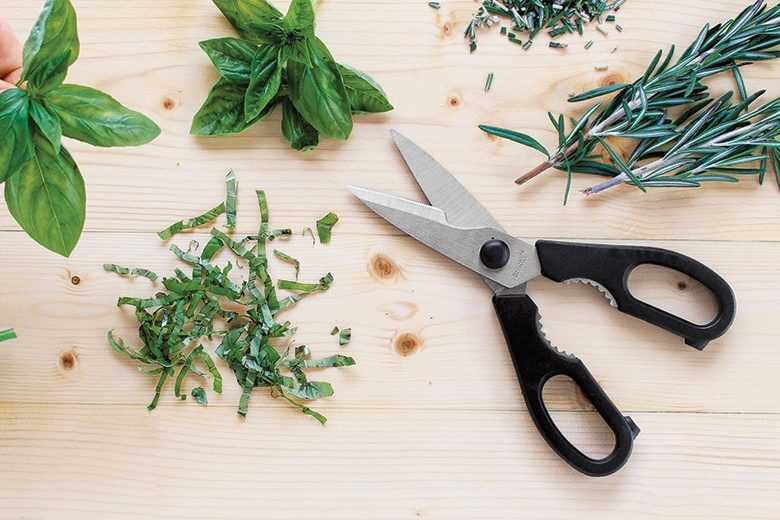
What can be snipped, snapped or crunched with kitchen shears? The list is seemingly endless: fresh herbs and leafy greens, bacon, poultry meat and cartilage, dried fruit, fish, pie dough, whole canned tomatoes, crab claws, fresh noodles, sundried tomatoes, broccoli and cauliflower florets, pizzas, quesadillas, pita bread and more.
An added advantage: No cutting board — meaning fewer dishes to wash. ![]()
Although kitchen shears may seem similar to scissors, the blade’s pivot point, or fulcrum, is farther from the handle than it is on scissors. This makes kitchen shears stronger with better cutting force, which comes in handy when cutting thick, slippery foods such as poultry and meat. In addition, kitchen shear blades are typically longer than scissor blades and have a larger, more oblong bottom handle to allow for a roomy, comfortable grip. Another important feature of kitchen shears is that the blades can be removed for cleaning and drying, which is critical for preventing rusty hinges and foodborne illness.
You can select from various specialty shears and also choose different handle and blade materials, along with snazzy added features such as bottle openers, screw cap and jar openers and nut or shellfish crackers.
Multi-purpose kitchen shears are available with professional-grade carbon steel blades — which often are coated with stainless steel, chrome or nickel to prevent rusting — or stainless steel, which also are rust-resistant, but are less sharp and more difficult to sharpen than carbon steel blades. For handles, choose from shiny all-metal varieties, which are pretty to look at, or shears with polypropylene or silicone-coated handles, which are more comfortable to hold and provide better grip. Other features may include adjustable pivot screws for tightening or loosening tension (available on some professional models); a projecting shank, a.k.a. tang, that extends into the handle for better balance and to help prevent the handle from cracking; serrated blade edges, which grip slippery foods better but aren’t as easily sharpened as smooth blades; and offset blades to better cut foods at an angle.
Poultry shears are curved in a crescent shape, making it easier to cut whole chicken and turkey. Although they’re designed for cutting up poultry, these shears also work well for removing scales and fins from fish and stripping fat from meat. Models with blunt tips can help prevent meat from tearing apart. Like multi-purpose kitchen shears, different types of handles and blades are available for any preference or budget.
Herb shears and snips offer an easy way to delicately cut fresh herbs and preserve their natural, aromatic and flavorful oils. Choose from multi-blade herb shears to slice through fresh herbs quickly (herbs can get stuck easily, so clean them thoroughly), or single-blade herb shears or snips that have smaller and shorter blades than kitchen shears and are often made of serrated metal for more precise cutting. When using herb snips rather than a knife to cut herbs, chances of slipping and cutting a finger are dramatically reduced.
After each use, disassemble any removable blades and wash by hand or, if specified, in the dishwasher and dry with a soft cloth. An occasional drop of food-grade mineral oil on the joint near the screw will keep kitchen shears in good working condition for years to come.


